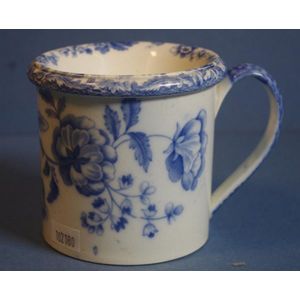Lyre Bird Landscape Jug by Boyd and Douglas
You must be a subscriber, and be logged in to view price and dealer details.
Subscribe Now to view actual auction price for this item
When you subscribe, you have the option of setting the currency in which to display prices to $Au, $US, $NZ or Stg.
- Incised - A record of a name, date or inscription, or a decoration scratched into a surface, usually of a glass or ceramic item with a blunt instrument to make a coarse indentation. Compare with engraving where the surface is cut with a sharp instrument such as a metal needle or rotating tool to achieve a fine indentation.
- Earthenware - A basic ceramic material that is fired at a low temperature. Earthenware is the basis of almost all ancient, medieval, Middle Eastern and European painted ceramics. After firing, the colour is the colour of the clay when it is dug from the ground: buff, brown and red. It is not waterproof until glazed. Creamware is a type of earthenware covered with a transparent lead glaze. Majolica, faience and delft are also earthenware covered in an opaque white tin glaze.
- Lyre Motif - The lyre motif is an ancient decorative design that is believed to have originated in ancient Greece, where the lyre was a popular musical instrument. The lyre itself was often decorated with ornate carvings and designs, including the iconic lyre motif.
In ancient Greek mythology, the lyre was associated with the god Apollo, who was the patron of music and the arts. The lyre was said to have been invented by the god Hermes, who presented it to Apollo as a gift. As a result, the lyre became a symbol of creativity, inspiration, and artistic expression.
The lyre motif typically features a curved or S-shaped body, with strings extending upwards from the base. The motif was often used in architectural decoration, as well as on pottery, jewellery, and other decorative objects.
This item has been included into following indexes:
Visually similar items

Vintage Royal Doulton 'Gloria' cream jug, D4937, Reg. No. 715051. Figural floral decoration. Height 9 cm.

Copeland & Garrett Spode blue & white spittoon, C1833, pattern: floral, factory mark to base (early restoration)

A First period Worcester 'Cracked Ice' Ground pattern tankard, circa 1765. A First period Worcester 'Cracked Ice' Ground pattern tankard, circa 1765 of bell shape with loop handle, painted in underglaze blue and depicting an Oriental figure seated in lands

An English Sadler Royal mug commemorating the visit to Australia by King George VI & Queen Elizabeth, 1949
